On Feb. 8-10, a series of roadside bombings in northern Benin’s W National Park killed seven employees of the conservation group African Parks, including four rangers and a French anti-poaching trainer.The attack is suspected to have been carried out by Islamist militants based in the forests of neighboring Burkina Faso, raising fears that violence in the Sahel is spilling over into Benin, with the country’s national parks as its front line.Over the border in Burkina Faso, militants have targeted forestry and conservation officials, hoping to capitalize on local discontent over park restrictions and gain new recruits.According to some researchers, African Parks has been thrust into the uneasy role of border security and “counter-terrorism” in northern Benin.See All Key Ideas
In early February, wildlife rangers in the remote northern forests of West Africa’s Republic of Benin became some of the most recent victims of the Sahel’s long-running Islamist insurgency when a series of roadside bombs was set off next to one of their patrols. After a rescue team in four vehicles arrived to evacuate the wounded and dying rangers, more bombs were detonated.
The attack was devastating. In tandem with another IED ambush just two days later, it left four rangers dead along with two drivers and a French anti-poaching trainer. Twelve more people were hospitalized. All were employees of African Parks, a South African conservation group that manages two national parks in northern Benin, including W National Park, the site of the bombings. In a statement, African Parks called the ambush “extremely complex,” saying it had been planned to cause as many casualties as possible.
The bombings were the worst in a series of cross-border terrorist attacks in northern Benin that began last year and which have escalated in the first months of 2022, as militant Islamist groups operating out of Burkina Faso make ever more brazen incursions into the coastal nation. In the days after the attack, France launched retaliatory air strikes in Burkina Faso, killing what a spokesperson for the French military told Mongabay were 40 members of an “armed terrorist group.” According to the Wall Street Journal, they are thought to have been connected to Ansarul Islam, a group active in Burkina Faso that has ties to al-Qaeda.
For African Parks, the ambush was the clearest sign yet that its mission in Benin has become far more dangerous and complicated than it expected when it signed a deal with the government to take over management of W National Park in 2020. Along with W, African Parks patrols the nearby Pendjari National Park, a 4,800-square-kilometer (1,850-square-mile) wildlife reserve to the south.
Savanna vegetation near Point Triple in the W National Park. Image by Marco Schmidt via Wikimedia Commons (CC BY-SA 3.0).
Together, the two parks comprise Benin’s portion of the famed W-Arly-Pendjari Complex, a vast expanse of wild landscapes that traverse Benin, Burkina Faso and Niger. The W-Arly-Pendjari Complex is considered to be one of West Africa’s most important biodiversity refuges, a sprawling 34,000-km2 (13,100-mi2) network of Sahelian savannas and forests that are home to some of the region’s last remaining lions, cheetahs and giraffes. With 70 species of mammals, including around 9,000 savanna elephants, African Parks calls W-Arly-Pendjari the “largest intact wild ecosystem in West Africa.”
But on the Burkinabe and Nigerien side, W-Arly-Pendjari has also become a haven and staging ground for some of the Islamist groups that have caused mayhem in the Sahel in recent years. Eager to escape French warplanes and take charge of smuggling routes, groups like the al-Qaeda-affiliated JNIM and the Islamic State in the Greater Sahara (ISGS) have set up camps in its near-impenetrable forests. For conservationists working in the region, their arrival has been deadly.
In Burkina Faso, by some accounts state forestry officials were among the first targets of militants looking to establish a foothold in the region, both to eliminate prying eyes and to capitalize on local resentment over regulations that prevent hunting and cattle grazing inside the parks. And last year, Rory Young, the founder of ranger-training outfit Chengeta Wildlife, was killed in an ambush along with two Spanish filmmakers while they were on an anti-poaching patrol in Arly National Park, just across the border from Pendjari.
With the February attack in Benin, long-held fears over the prospect of Sahelian violence spilling over into West Africa’s coastal countries appear to be coming true. And African Parks has found itself at the front line.
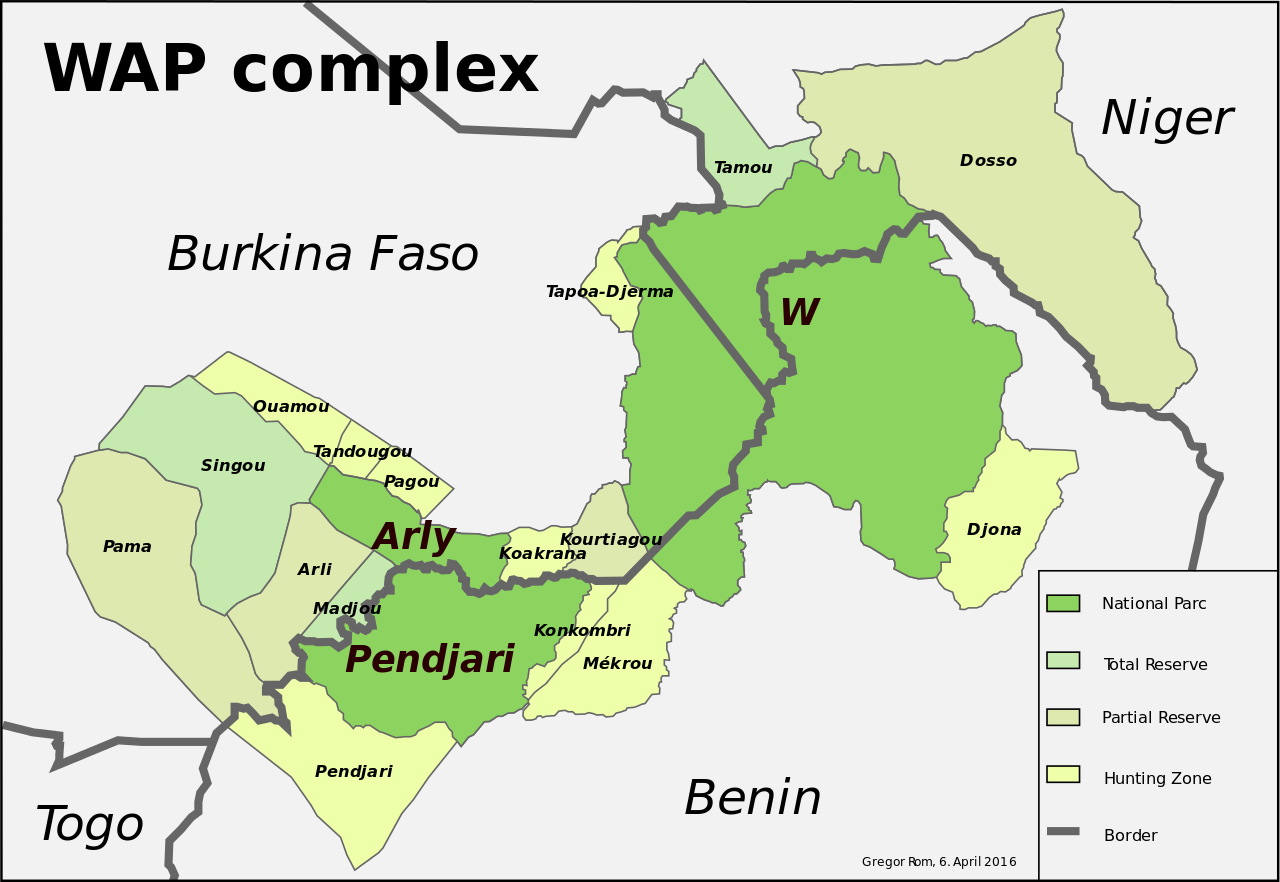 WAP complex (national parks W, Arly and Pendjari) in Benin, Burkina Faso and Niger. Image by Gregor Rom via Wikimedia Commons (CC BY-SA 4.0).
WAP complex (national parks W, Arly and Pendjari) in Benin, Burkina Faso and Niger. Image by Gregor Rom via Wikimedia Commons (CC BY-SA 4.0).
Both W and Pendjari share a border with Burkina Faso, and the group’s 150 or so wildlife rangers are trained in military tactics and equipped with high-tech gear that often outclasses that of the Beninese army. According to some reports, as militant groups have crept closer to the border of the two parks — and on a few occasions crossed it — African Parks has been tracking their movements, sharing the information it gathers with Benin’s security forces and Western intelligence services.
In research published last year by the Armed Conflict Location & Event Data Project (ACLED) and Dutch think tank the Clingendael Institute, African Parks was described as akin to a “counter-terrorism unit” — a charge the group vehemently denies. Better armed and paid than their counterparts in Benin’s military and tasked with defending the territorial boundaries of W and Pendjari, African Parks rangers were said to have been drifted into the uneasy role of a border security force. This position, its authors warned, risked turning rangers into targets.
In northern Benin, a mission that began as one focused on high-end tourism and wildlife protection has taken a perilous turn, as the pull of yearslong fighting in the Sahel blurs the line between conservation and counterinsurgency.
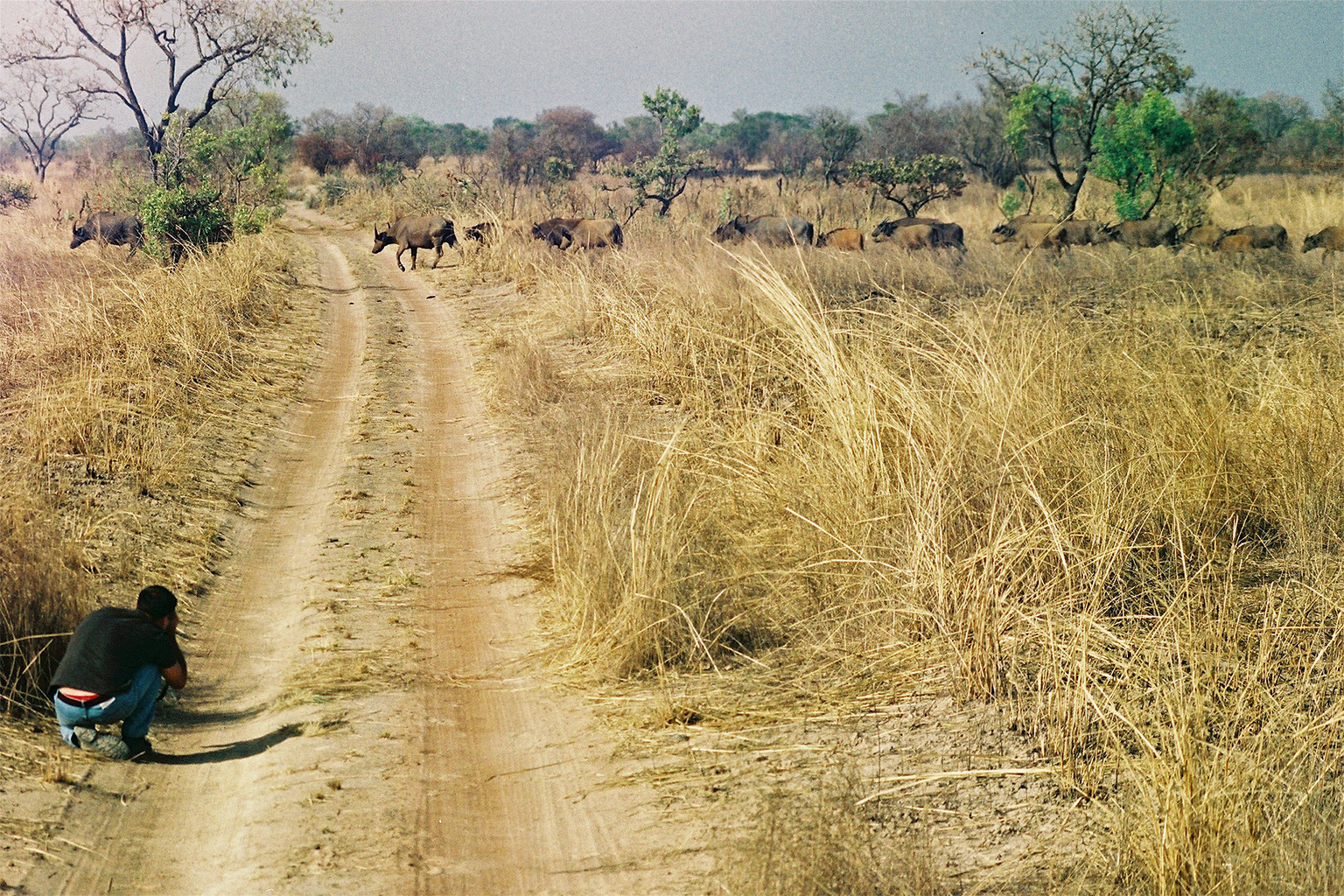 A tourist photographing water buffaloes in Pendjari National Park, Benin. Image by Hugo van Tilborg via Flickr (CC BY-NC-SA 2.0).
A tourist photographing water buffaloes in Pendjari National Park, Benin. Image by Hugo van Tilborg via Flickr (CC BY-NC-SA 2.0).
A public-private partnership for Benin’s parks
It wasn’t supposed to be like this for African Parks or Benin’s northern wildlife reserves. In 2018, when President Patrice Talon announced a public-private partnership with the group, it was an exuberant moment. Years of poor financing and oversight of the remote parks had led to a collapse in its wildlife populations, as local hunters and cattle grazers pushed further into its boundaries, degrading the landscape and opening up access routes for poachers. Between 2011 and 2017, nearly 1,000 elephants were killed in Benin and Burkina Faso. African Parks said it had the answer: secure the boundaries of the parks, step up law enforcement, and develop infrastructure for profitable safaris and hunting trips.
“The international collaboration for this reserve is extraordinary, especially because it comes at a time when my government is committed to making tourism a lever for long-term development,” Talon said at the time.
African Parks was founded in 2000 by the Dutch industrialist Paul van Vlissingen. As the story goes, he came up with the idea after a 1998 meeting with the then-president of South Africa, Nelson Mandela. Vlissingen was concerned about the poor shape of the country’s national parks; Mandela said he had to focus on poverty reduction, but urged Vlissingen to put his money to work protecting wildlife on his own. Thus was born African Parks, a nonprofit organization backed by funding from wealthy donors in the EU and U.S. whose mission is to rehabilitate ailing wildlife reserves across the continent.
Unlike other conservation organizations, African Parks is a one-stop shop. Groups like WWF sign agreements with host governments to manage national parks, but the rangers who patrol their boundaries are typically under at least the nominal command of state agencies. African Parks, on the other hand, maintains its own 1,000-strong force of rangers, who are trained in paramilitary tactics by instructors from across the world, including the U.K., Israel, and France. Governments who contract African Parks to manage one of their national parks have a say in the management plan, but once they turn over the keys they’re expected to mostly step back from day-to-day operations.
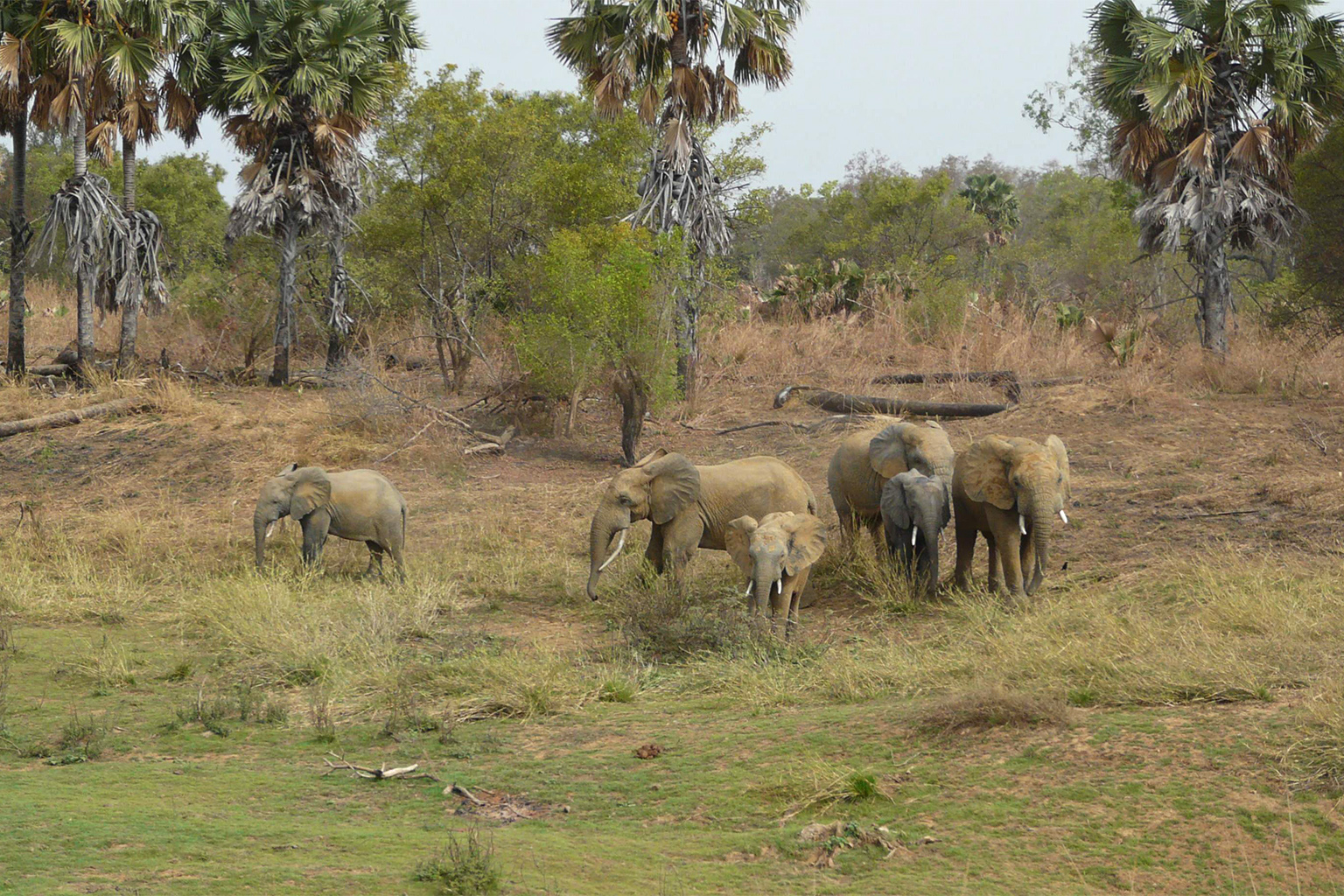 Elephants in Pendjari National Park. Image by Marc Auer via Wikimedia Commons (CC BY 2.0).
Elephants in Pendjari National Park. Image by Marc Auer via Wikimedia Commons (CC BY 2.0).
African Parks says that maintaining direct control over its ranger force allows it to discipline those who misbehave or abuse local people, helping to avoid scandals like the WWF’s human rights debacle in Central Africa and Nepal. Maintaining good relationships with communities living around the parks it manages, which now cover a staggering 15 million hectares (37 million acres) in 11 countries, is a top priority, a spokesperson told Mongabay.
“What we’ve learned across our parks is obviously you need to have community support,” said Charles Wells, the chief operating officer of African Parks. “That’s a big key of our theory of change, is that well-managed protected areas actually benefit communities.”
But strict law enforcement and a robust defense of park boundaries is the core of its approach, one that’s been described as “fences and fines.” Critics say it’s a poster child for “fortress conservation,” and worry that its emphasis on paramilitary patrols can be dangerous for people entering the parks to fish or hunt small game. The group’s admirers scoff at that criticism, pointing to African Parks’ track record of rehabilitating degraded wildlife habitats, which they say speaks for itself.
One of those admirers is reported to be Rwandan President Paul Kagame. After the group took over Akagera National Park, visitor numbers more than doubled, bringing in tourist dollars and winning praise from conservationists. According to rumor, it was Kagame himself who sold Talon on the idea that African Parks could do for Benin what it had done for Akagera. Not long after he returned from a state trip to Rwanda in 2016, Talon announced it would be taking over Pendjari, in its first foray into West Africa.
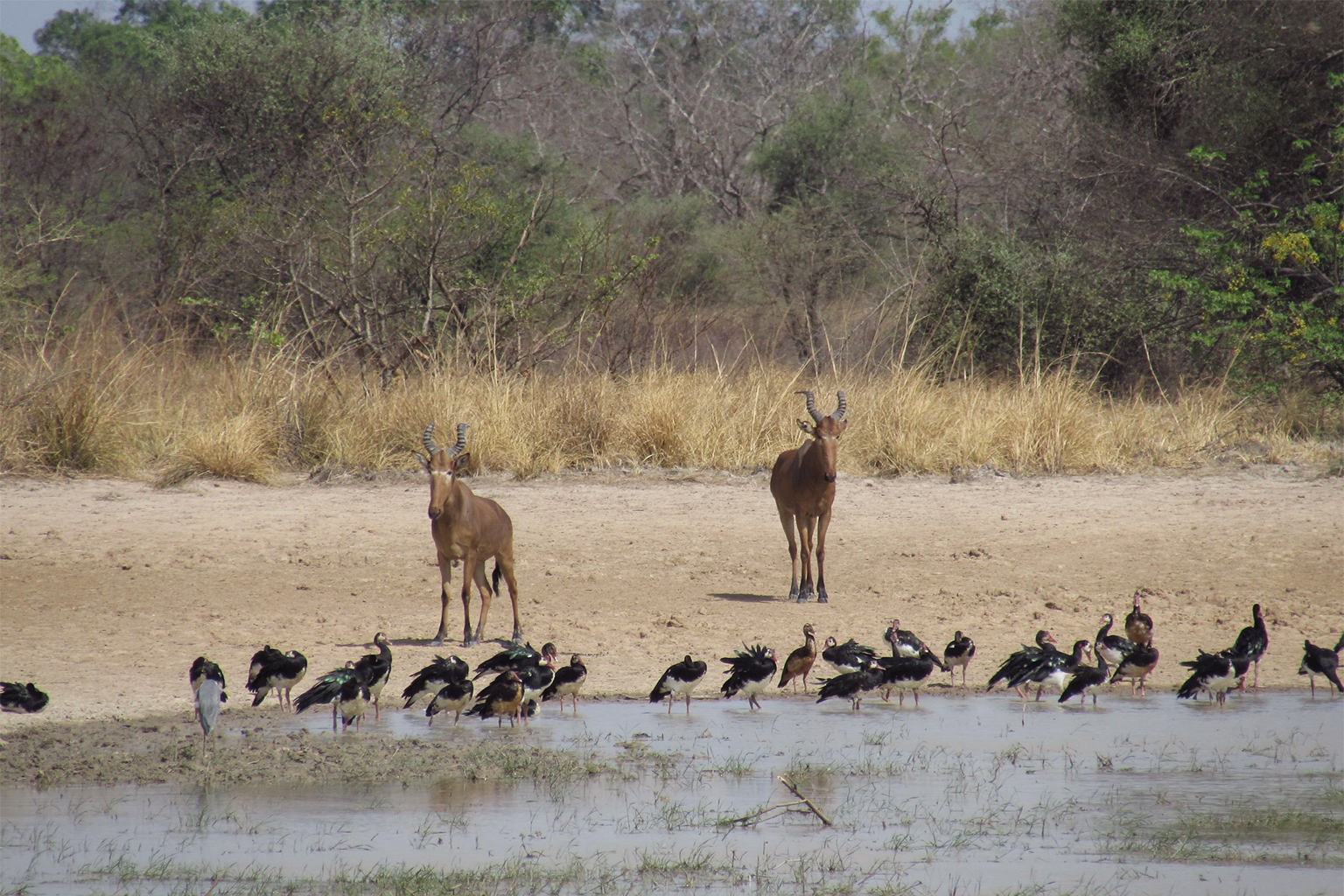 In some parks managed by African Parks, wildlife populations have increased, drawing tourists from abroad. Image by Gregor Rom via Wikimedia Commons (CC BY-SA 4.0).
In some parks managed by African Parks, wildlife populations have increased, drawing tourists from abroad. Image by Gregor Rom via Wikimedia Commons (CC BY-SA 4.0).
Early troubles lead to a ‘turning point’
In the years before African Parks took it over, Pendjari had been managed by Cenagref, the Beninese government agency responsible for wildlife reserves. But after EU funding ran dry, supervision of Pendjari and W withered. Often, underpaid Cenagref agents just looked the other way when local hunters, farmers and cattle ranchers — or in some cases, poachers — crossed over into the park.
“[Cenagref] needed some improvement,” said Etotépé Sogbohossou, who wrote her Ph.D. on human-wildlife conflict in Pendjari and is now director of the environment department at Egypt’s University of Alexandria. “It was a problem. There was a need for a change in protected areas management, and bringing African Parks in was the solution they found.”
Right away, Beninese conservationists and communities living around Pendjari knew the arrival of African Parks meant just that: change. Suddenly, areas that had long been used by villagers for fishing, ancestor worship, or hunting were closed off by armed rangers. At first, even local researchers and their students were barred from entering the park.
“In my time, we didn’t train rangers as a military,” said Brice Sinsin, a professor of agricultural sciences at Benin’s University of Abomey-Calavi. “We trained them much more as naturalists. But when I discussed with some of the [rangers], they didn’t even know the name of any plants and so on. The system was much more military-oriented than we were used to.”
 A village just outside Pendjari National Park. Image by Denise Miller via Flickr (CC BY-NC-ND 2.0).
A village just outside Pendjari National Park. Image by Denise Miller via Flickr (CC BY-NC-ND 2.0).
The new regime startled and angered people living around Pendjari. In a dynamic familiar to conservation projects across the world, some were bitter that the forests they’d been using for decades, or even centuries, were now almost entirely off-limits. According to an analysis by the French peacebuilding nonprofit Promediation, in one incident rangers killed an entire herd of nearly 450 cattle inside the park, incensing the owners and ratcheting up tensions in some communities.
“They had many issues in the beginning at Pendjari park,” said Kars de Bruijne, head of the Sahel program at the Clingendael Institute’s conflict research unit. “The director was really bad and they had lots of problems with communities in 2017 and 2018. But things have changed since 2019. The management became more sensitive.”
From the perspective of African Parks and the Talon administration, protecting threatened wildlife inside Pendjari, including West Africa’s last savanna elephants, required rangers to take a tough approach. But Wells denied there had been systemic conflict with communities.
“We haven’t had open conflict with communities,” he said. “I’m not saying everybody in the community agrees — of course not — there are people who don’t agree, and we try to address that through dialogue and community projects. As the benefits flow to people, over time they realize that it’s actually in their best interests to have a protected area with sustainable resource management. But poaching and illegal behavior, obviously we do address, and we have arrested poachers.”
Tensions around Pendjari boiled over in February 2018, when a group of local hunters ransacked one of African Parks’ field offices. Then, just over a year later, a group of French tourists were kidnapped while on holiday in the park. Their guide was brutally murdered, and intelligence agencies feared the tourists were en route to be sold to Islamist militants who had by then begun to creep into southeastern Burkina Faso. But the tourists were rescued by French special forces in a nighttime raid before a handover could take place.
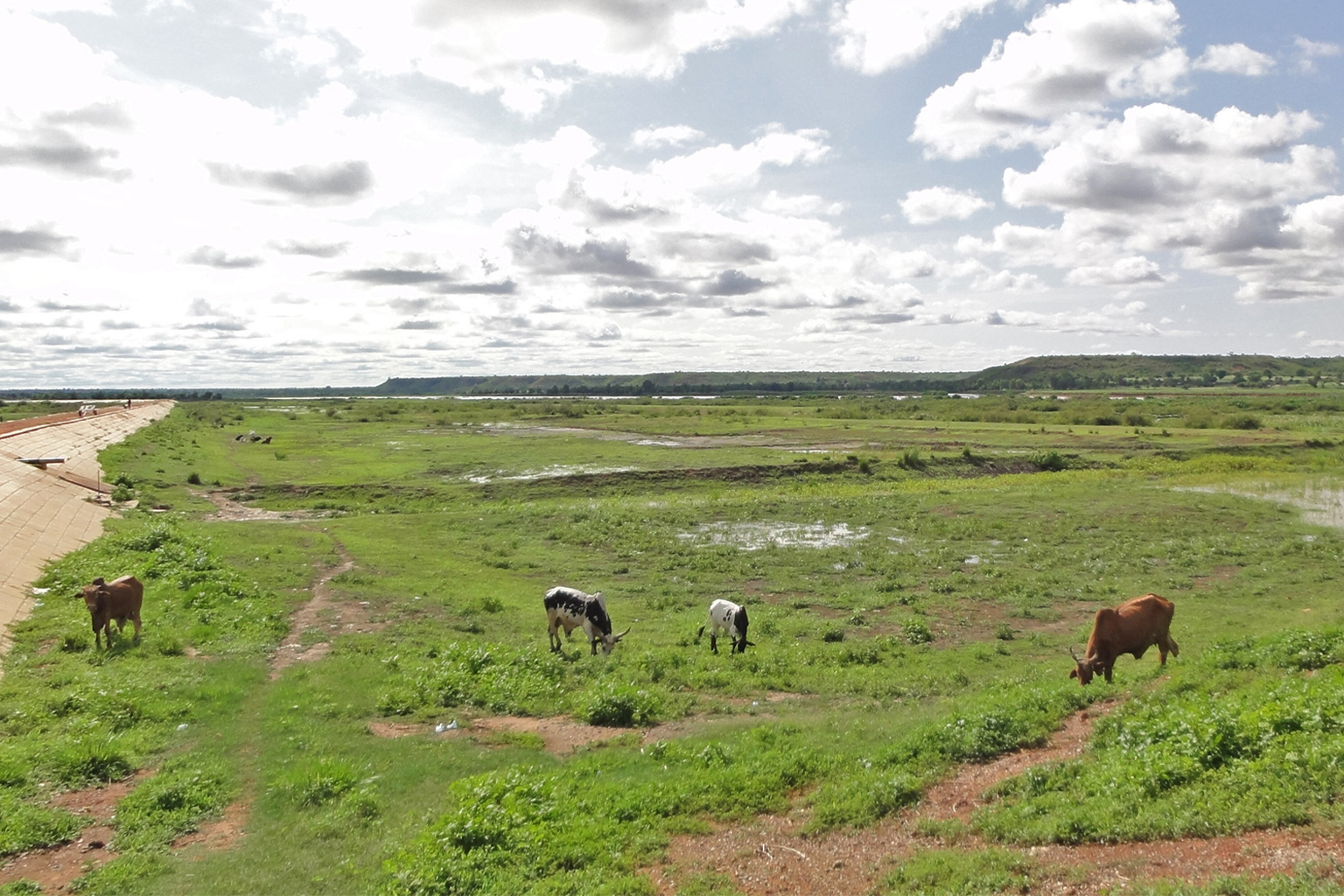 Cattle in Benin. Fulani cattle herders who used to graze their animals inside the park’s grasslands have found some of their old routes closed off to them by park restrictions at W and Pendjari. Image by Africa Rice Center via Wikimedia Commons (CC BY-SA 3.0).
Cattle in Benin. Fulani cattle herders who used to graze their animals inside the park’s grasslands have found some of their old routes closed off to them by park restrictions at W and Pendjari. Image by Africa Rice Center via Wikimedia Commons (CC BY-SA 3.0).
According to an anonymous African Parks staffer quoted in the Promediation report, the kidnappings were a “turning point” for the organization. Violence related to the Sahel’s debilitating crisis had punctured Benin’s border for the first time, and overnight the need to cool off tensions around Pendjari took on an added layer of urgency. The group decided to open up some parts of the park to locals, under the watchful eye of rangers, and began focusing more of its energy on community development projects.
“We’ve also formalized access to the parks. It’s controlled access, but it’s allowed legal access for things like fishing and natural resource harvesting,” Wells said.
The changes were noticeable, and as they were implemented, conflict between African Parks and locals began to subside. Then, in 2020, Talon made another announcement: the group had also been given a contract to manage W National Park, which shares a border with both Niger and Burkina Faso. Named after a W-shaped bend in the Niger River, the park was in even worse shape than Pendjari, with tens of thousands of cattle moving through in herding routes every year and an ever-advancing front of crops planted inside its boundaries by farmers.
“The Government has shown significant foresight in positioning conservation as a catalyst for sustainable development with the integration of protected areas in their Revealing Benin investment programme, first with Pendjari and then with W,” Peter Fearnhead, CEO of African Parks, said in a press release describing the new partnership.
But across the border, Islamist militants were busy extending their own franchise. And that meant killing conservationists.
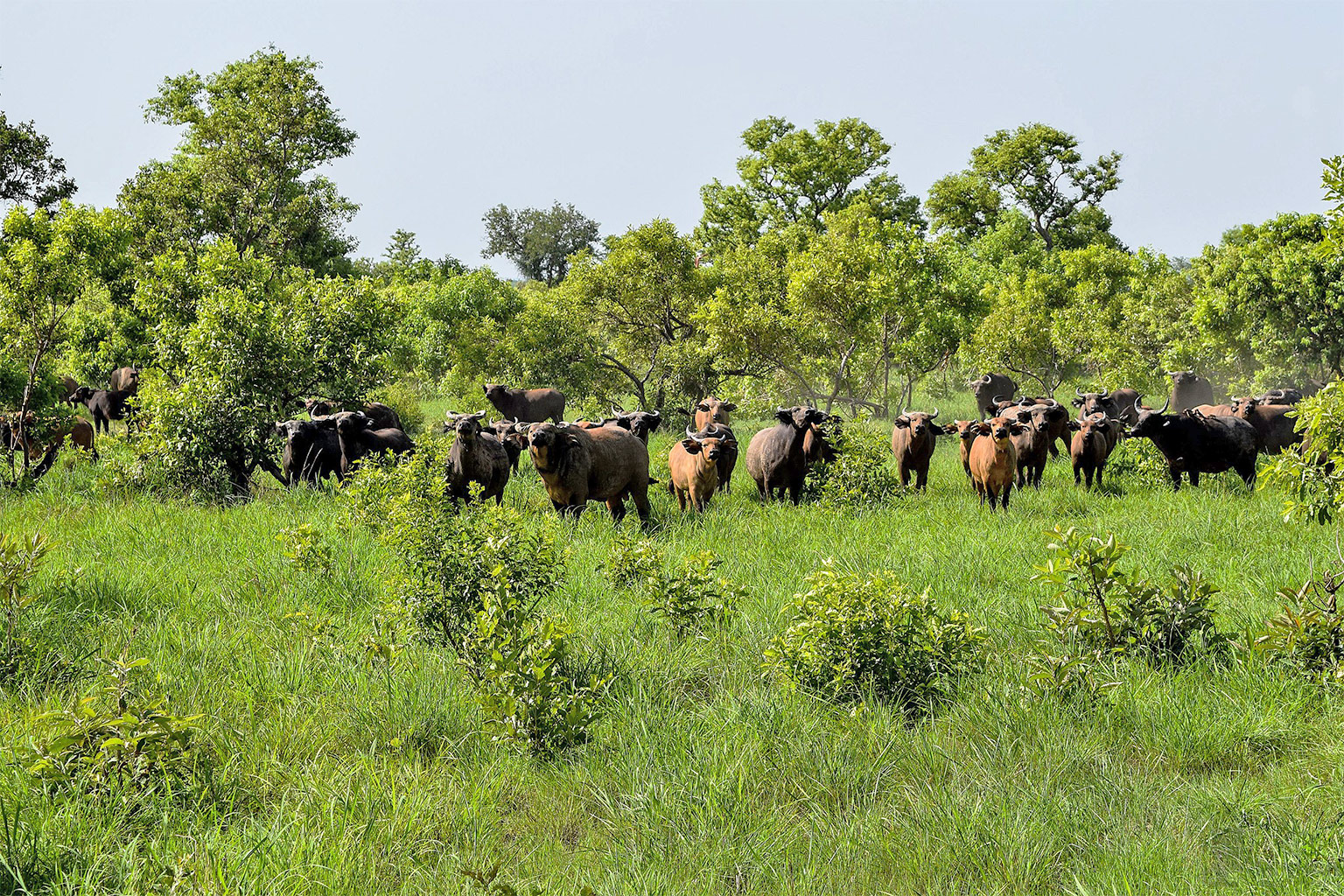 A herd of buffaloes in the Pendjari National Park. Image by Padonou Dotou via Wikimedia Commons (CC BY-SA 4.0).
A herd of buffaloes in the Pendjari National Park. Image by Padonou Dotou via Wikimedia Commons (CC BY-SA 4.0).
A thin green line
In eastern Burkina Faso, a worrying dynamic had begun to emerge along with the arrival of militant groups fleeing airstrikes and French troops elsewhere in the Sahel. Among the first targets of those groups were forestry and park officials tasked with managing the Burkinabe side of W-Arly Pendjari. On one hand, the killings were a strategic necessity for the militants: to operate freely in the parks, they needed to purge them of anyone who might report their location. But they were also intended to send a message to people living in the region, many of whom had long been angry at rules that prevented them from exploiting the parks’ resources.
“The narrative these extremist groups have used in the Burkinabe side of the park is to say to the communities, we are giving your park back,” De Bruijne said. “The way it was operated by the forest guards of Burkina, for example, was very corrupt. As a poacher or a community relying on these parks, you would have to pay and bribe them. And the narrative [the groups] came with is, these are your grounds and now you can go into them.”
Across the border in Benin, the growing presence of the militants was setting off alarm bells. In June 2020, according to the Promediation report, a group of African Parks rangers bumped into a group of twelve armed men in W National Park who spoke Arabic and were carrying AK-47s. The men said they were just passing through and the encounter didn’t lead to violence, but African Parks was reported to have tracked them with a helicopter until they left the park, sharing information about their movements with Benin’s security forces.
The encounter was emblematic of the shaky position that African Parks had suddenly found itself in. By virtue of its proximity to Burkina Faso and location along a route to northern Nigeria, it was now rubbing shoulders with the same heavily armed and very dangerous militants that had destabilized countries across the Sahel during a decade of fighting. Due to its commitment to patrol W and Pendjari for intruders, African Parks had become a first line of contact with those militants in large swaths of northern Benin.
Hoping to map security threats in the region, De Bruijne and ACLED carried out a conflict assessment of the area near the two parks. Working with a reporting network in northern Benin, he directed a series of anonymous interviews with local officials, community representatives, and former employees of African Parks, publishing the findings of his research in a lengthy report in June 2021.
“One of the things that came up consistently was issues over the management of the parks,” De Bruijne told Mongabay in an interview. “Sometimes it involved African Parks, sometimes it involved other officials, and sometimes it was just a clash with poachers. When we reviewed the data we realized that there was something ongoing there that had been brewing for some time.”
From what De Bruijne’s sources told him, African Parks was in large part the only thing standing between jihadists in Burkina Faso and Benin’s parks. And the group was aware of it, working with donors to gather and share intelligence on militant activities in W-Arly-Pendjari. At times, he wrote, rangers had crossed over into Burkina Faso and even directed the operations of Beninese units.
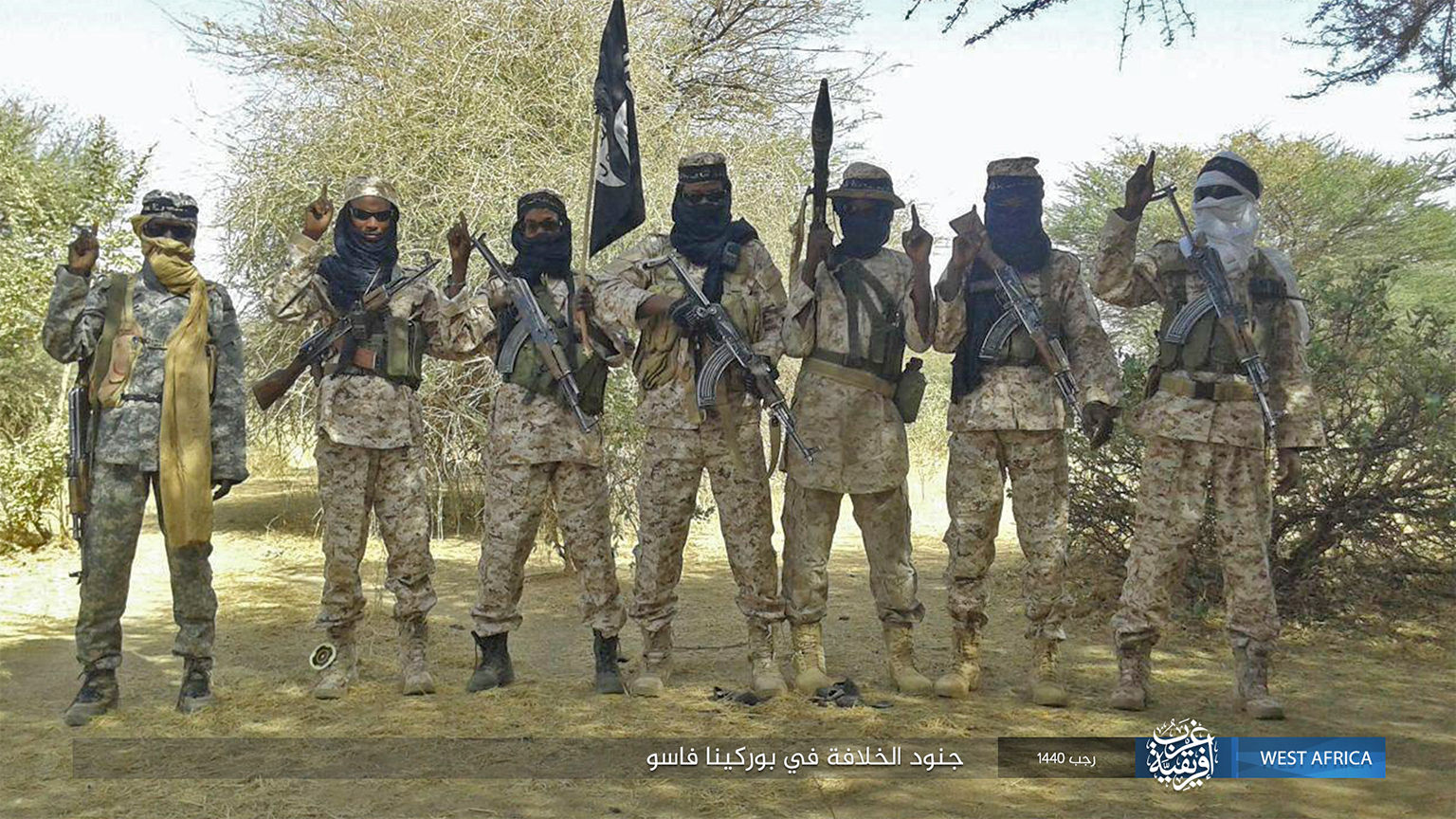 Militants with the Islamic State in the Greater Sahara (ISGS) in Burkina Faso. As Burkina Faso Salafi militants extended their franchise into eastern Burkina Faso, some of their first targets were forestry and park officials. Image by aharan_kotogo via Wikimedia Commons (CC BY-SA 4.0).
Militants with the Islamic State in the Greater Sahara (ISGS) in Burkina Faso. As Burkina Faso Salafi militants extended their franchise into eastern Burkina Faso, some of their first targets were forestry and park officials. Image by aharan_kotogo via Wikimedia Commons (CC BY-SA 4.0).
“I got information that they were in some operations commanding the army in the north, and that was really strange,” he said. “Because then who is actually in charge of the security situation?”
African Parks did not receive the ACLED report well. In a scathing letter, the group said it was riddled with “falsehoods, confused, or distorted anecdotes, and bias.” It criticized De Bruijne for relying on confidential sources instead of reaching out directly to senior management and accused him of making “libelous claims.” The assertion that it was involved in counterterrorism operations or in command of Beninese units was, its spokesperson wrote, “categorically false.”
The group also dismissed the report in an interview with Mongabay, calling some of its conclusions “bizarre.”
“We talk to the military and we obviously have to coordinate movements at times if we operate in the same area, so there’s definitely coordination and communication,” Wells said. “But definitely not that they fall in our chain of command — absolutely not.”
The Promediation report, though, also noted close ties between African Parks, the Beninese military, and Western intelligence services, saying that rangers often conduct joint patrols with soldiers, who rely on the group’s aerial capabilities to monitor the border. One Beninese official was quoted as saying that absent the presence of African Parks, “there would certainly be jihadists in the Pendjari Park already.” Florent Geel, deputy general director of Promediation, told Mongabay he thinks the group was sucked into a role that it didn’t expect — and didn’t want.
“I don’t think there’s any hidden mission to be border control or whatever,” Geel said. “I think they’re trapped in this situation, and it’s become much more complex for them.”
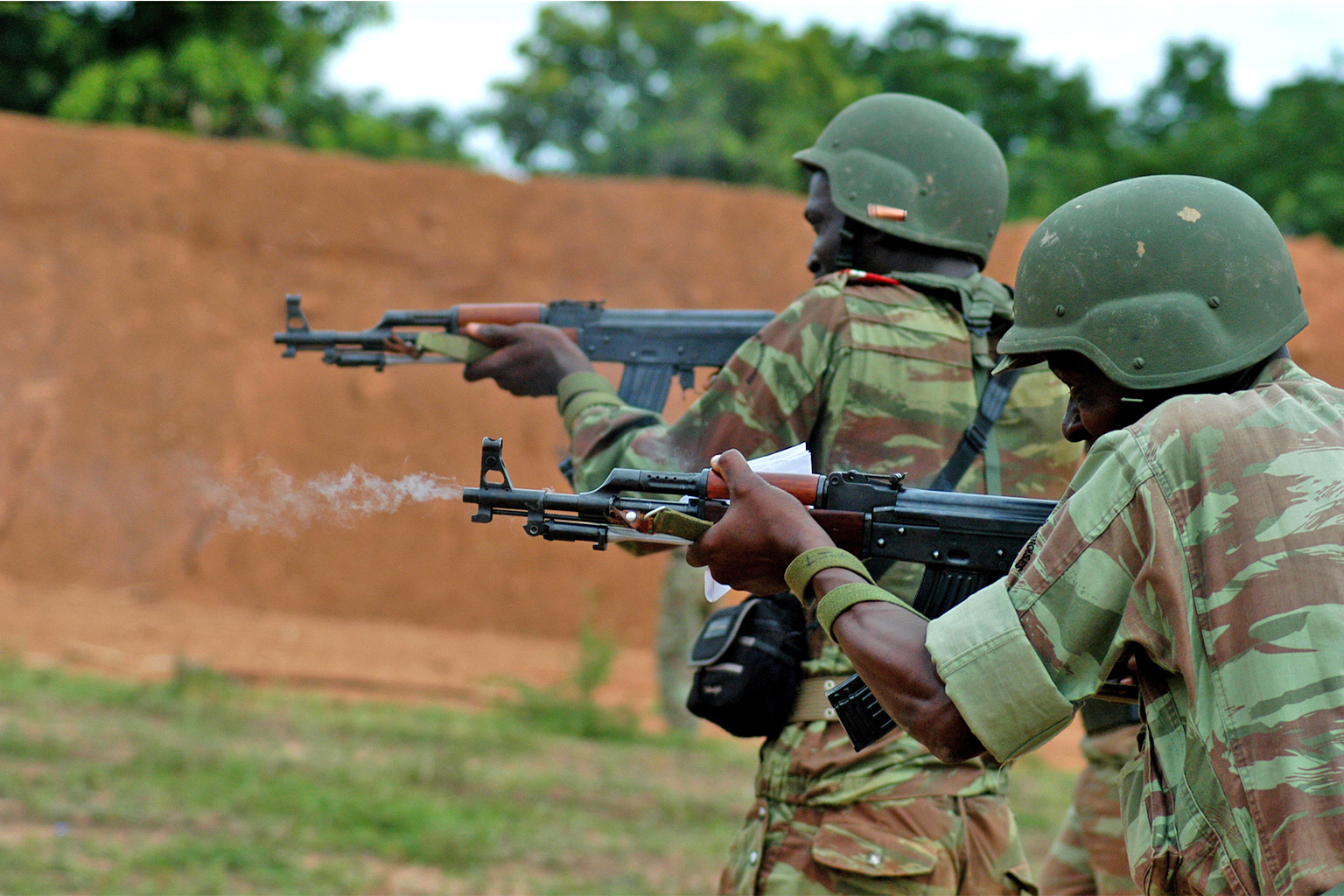 Beninese Army soldiers taking part in live fire exercise. Image by Jad Sleiman, U.S. Marine Corps via Wikimedia Commons.
Beninese Army soldiers taking part in live fire exercise. Image by Jad Sleiman, U.S. Marine Corps via Wikimedia Commons.
Conservation in a crowded neighborhood
By late 2021, it was becoming clear that a confrontation with militant groups in northern Benin had begun. Deadly IED attacks and other ambushes began occurring more frequently into the beginning of 2022, culminating in the Feb. 8-10 roadside bombings that killed eight African Parks staffers.
Wells called the suggestion that the rangers were specifically targeted in the attack “speculation,” but said that African Parks has since ordered its staff to withdraw from border areas and focus on protecting core wildlife habitats until security improves.
“We don’t want to operate right up at the border where the real insecurity and threat is,” he said. “With our agreements, it’s for the military to do that role, so we’ll stay out of their way.” (African Parks declined to make a copy of those agreements available to Mongabay.)
The violence at W and Pendjari presents difficult questions not just for African Parks, but for conservationists across the continent. The Benin parks contain some of the last intact wild landscapes in West Africa, and while the strict measures adopted by African Parks may have drawn the ire of locals, they’ve also been effective in stopping poaching. According to a spokesperson for the group, wildlife populations in Benin’s side of W-Arly-Pendjari are denser than in Burkina Faso or Niger. Seventy-one percent of the complex’s remaining elephants are in Benin, for example, compared with 26% in Burkina Faso and 3% in Niger.
“Since African Parks has started managing [Pendjari], poaching is low. They’ve done the patrols in a good manner and are also very well equipped,” said Sinsin of Benin’s University of Abomey-Calavi.
But that accomplishment has come at the cost of placing African Parks in a combustible situation. The wildlife and resources of W-Arly-Pendjari may have intrinsic value for all humanity, but to those living in proximity to the parks they also have direct material value.
Fulani herders, for example, have typically used routes that pass directly through W National Park to water their cattle. When those routes were shut down, they were forced to take longer journeys that have in some cases put them in direct conflict with farmers when their crops are trampled by those herds. In other parts of West Africa, those conflicts have erupted into violence, raising the troubling prospect of conservation measures helping to spur similar clashes in northern Benin.
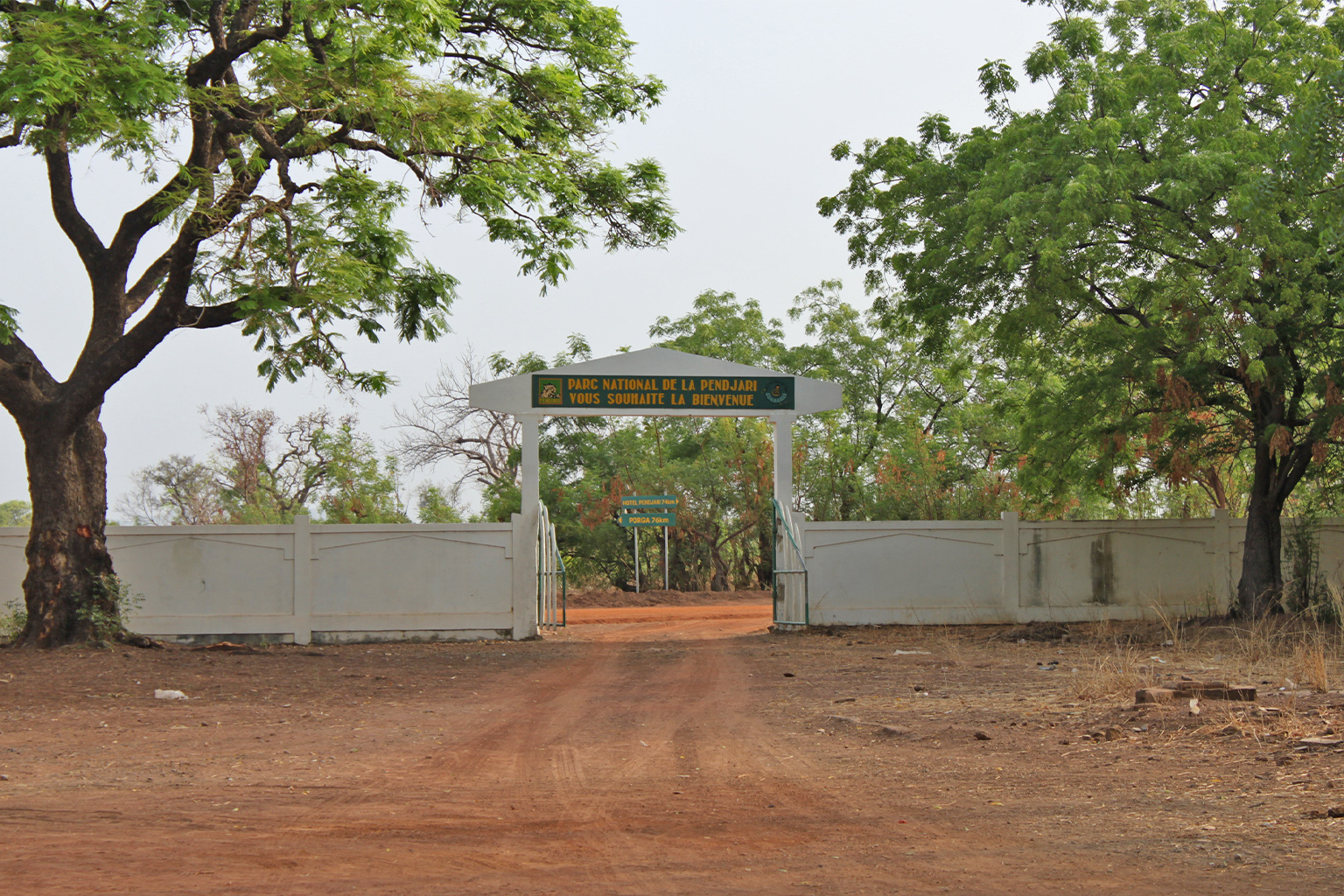 Gateway to the Pendjari National Park, in the northwest of Benin. Image by Fawaz.tairou via Wikimedia Commons (CC BY-SA 3.0).
Gateway to the Pendjari National Park, in the northwest of Benin. Image by Fawaz.tairou via Wikimedia Commons (CC BY-SA 3.0).
“In a place like eastern [Central African Republic], there’s a lot more space so it’s easier to share,” Wells said. “But in a place like northern Benin there’s much harder boundaries between us and between the pastoralists and agronomists.”
Across the border in Burkina Faso, it’s those Fulani herdsmen, resentful of the government’s perceived slights, including conservation-related restrictions on their livelihood, who have been the target of the most intense recruitment efforts by Islamist militants.
“People tend to neglect how conservation changes people’s modes of production and social relations, which are all tied to the land,” said Aby Sène, a conservation social scientist and assistant professor at Clemson University in the U.S. “They’re completely upended.”
In an email to Mongabay, a spokesperson for African Parks emphasized the group’s extensive, and costly, efforts to improve the lives of communities near W and Pendjari, saying it had refurbished three schools and hired 16 community facilitators who were “deployed all around the park to raise awareness for the conservation of wildlife and the park.” For cattle herders cut off from transhumance routes through W, African Parks offers free livestock vaccinations and has built alternative watering points.
Despite the worsening security situation and prospect of future attacks, the group says it’s in northern Benin for the long haul.
“At this point, we think the threat is such that it’s manageable, so we will keep operations going,” Wells said. “We will still have rangers updating their normal anti-poaching patrols and community engagement, which is key for any of our parks.”
But the militants lurking in Burkina Faso’s borderlands have proved capable of holding their own against some of the most powerful militaries in the world. If they are determined to advance into northern Benin’s wildlife reserves, it likely won’t matter how well-equipped or trained African Parks’ rangers are.
“In the Central African Republic or DRC where they’re facing some armed groups, it’s not the same,” Geel said. “Jihadist groups in the Sahel are much more experienced, much more violent, and much more effective. If they decide to attack [the parks] it will be very complex for African Parks to stay.”
Banner image: Beninese Army soldiers taking part in live fire exercise. But by the end of 2021, a series of attacks on soldiers by militants raised the specter of a long-feared spillover of insurgent violence into northern Benin. Image by Jad Sleiman, U.S. Marine Corps via Wikimedia Commons.
FEEDBACK: Use this form to send a message to the author of this post. If you want to post a public comment, you can do that at the bottom of the page.
![]()
Source link : https://news.mongabay.com/2022/03/in-benin-a-thin-line-between-conservation-and-counterinsurgency/
Author :
Publish date : 2022-03-29 07:00:00
Copyright for syndicated content belongs to the linked Source.





